Mozart
-------------
created 10/10
updated 3/4/17
Go to homepage
I love Mozart
especially his 27 piano concertos. For the last three years I have pretty
much abandoned the car radio and instead have listened mostly to my MP3
music library, which I have cycled though many times. It is about 3.5 Gb
(60 hours) of music, mostly classical and much of that Mozart, including
all of Mozart's 27 piano concertos plus most (if not all) of his other
concertos (flute, violin, horn, bassoon, clarinet, oboe, flute & harp).
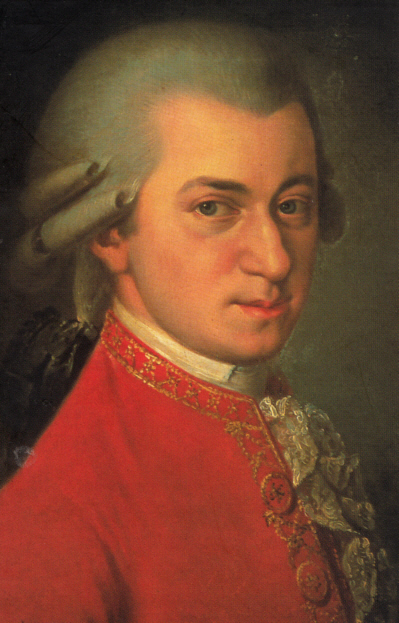 .
. 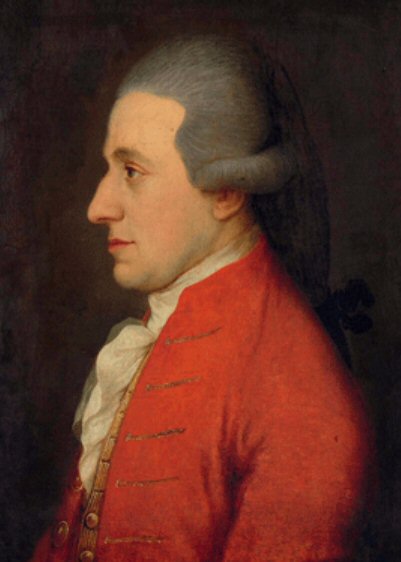
Mozart --- born: 1756, died: 1791 (age 35)
left: scan of my London, Vladimir Ashkenazy, boxed
set of Mozart piano concertos cover
This is the Krafft portrait painted from three other
portraits 28 years after Mozart died.
right: newly discovered (2004) possible Mozart portrait
Mozart's music
is always very listenable, and sprinkled all through Mozart's music are
these little gems. One of these little gems was featured in the
1984 movie Amadeus (below):
Salieri comments on Mozart's Serenade #10
in B flat for 13 wind instruments, K 361, as it plays in the background
http://www.youtube.com/watch?v=PGSzeHKgHfI&feature=related
(1984 movie excerpt with F. Murray Abraham as Salieri)
Mozart
- Serenade #10 in B flat for 13 wind instruments, K 361, Adagio.mp3
(local audio)
http://www.youtube.com/watch?v=Bs_Pya-s2io&feature=related
(online video)
"On the page
it looked nothing. The beginning simple, almost comic. Just a pulse - bassoons
basset horns - like a rusty squeezebox. And then, suddenly - high above
it - an oboe. A single note hanging there unwavering, until a clarinet
took over and sweetened it into a phrase of such delight. This was no composition
by a performing monkey. This was a music I'd never heard. Filled with such
longing, such unfulfillable longing. It seemed to me that I was hearing
a voice of God." (quote from 1984 movie Peter Shaffer's Amadeus)
This
quote is famous and easy to find online, but unfortunately what you find
online has a lot of the details wrong, especially the dramatic last line.
Online you find variants like: 'the very voice of God', 'the voice
of God', or 'a voice of God'. I edited the version above so it matches
(exactly) Shaffer's text as spoken by F. Murray Abraham as Salieri.
Here is an equally
famous excerpt from the movie where Salieri is looking at Mozart scores,
given to him by Mozart's wife, as they play in the background. Here Salieri
uses the phrase "the very voice of god". (One poster comments that Peter
Shaffer's Amadeus is a love letter to Mozart and that's pretty well
sums it up.)
http://www.youtube.com/watch?v=A5BpzmTIZMU
(Amadeous movie excerpt)
"He had simply, written down music already finished, in his head, page
after page of it, as if he were just taking dictation." (A partial confirmation
comes from the Library of Congress, which has some Mozart originals, and
reports that they do in fact show very few corrections.)
http://www.youtube.com/watch?v=-ciFTP_KRy4&feature=related
(Amadeous movie excerpt)
Mozart improvises on a Salieri piece
Mozart is the
only composer I know who in piano concertos often at dramatic moments has
the piano played one note at a time.
Mozart's music
is (probably) the music Washington, Adams, and Jefferson listened to, though
I have found no references saying this. Mozart died in 1791 just two years
after Washington began his presidency. Found a 2005 NPR 30 minute story
on Mozart and colonial music. The show's colonial music experts implied
that large skilled orchestras needed for much of Mozart's music probably
didn't exist in colonial America, but resources for scaled down orchestras
and chamber music did. There were small touring opera companies in US by
1750 and bands played for formal dances, like Washington's inaugural ball.
No doubt Franklin
in Paris 1776 to 1781 (Franklin born 1706 is age 70 to 75), during and
after the revolutionary war, heard some Mozart, since Mozart was age 20
to 25 in those years and quite famous, and interestingly, Mozart was in
Paris for six months in 1778. Doing a Google search I find that Franklin
and Mozart were both in London for six months in 1765, but at that time
Mozart was only age 9 and was touring as a child prodigy. Franklin clearly
had an interest in music. According to Wikipedia "Franklin is known to
have played the violin, the harp, and the guitar, and he also composed
music, notably a string quartet in early classical style." After hearing
music played on water glasses, Franklin invented an improved version, the
rotating glass amonica in 1761, when Mozart was five.
Did Franklin
and Mozart ever meet? There's a good chance that they did (one Mozart site
says they did). It would have been in Paris in 1778 when Mozart was 22
and Franklin 72. Both are celebrities in Paris, their visits overlap for
six months, both are interested in music and composing, but there is more.
Franklin has earlier invented a new music instrument, the rotating glass
harmonica, and Mozart later writes music for Franklin's glass harmonica.
It's very possible that Franklin may have shown & played his new instrument
for Mozart in 1778 and made an impression. Thirteen years later (in 1791,
the last year of Mozart's life) Mozart composes several pieces for Franklin's
rotating glass harmonica (also called the glass armonica) including the
Adagio for Glass Harmonica in C Major (K617a).
Most impressive
performance I could find on Franklin's glass harmonica (not Mozart)
http://www.youtube.com/watch?v=eQemvyyJ--g&feature=related
The first four
piano concertos (which I like) were written when Mozart was 11 years old!
(Musicologists say these are reworked Bach pieces and that some of the
writing is in his father's hand.) Mozart writes #5 at age 17 and the next
three (#6, #7, #8) at age 20 (three piano #7 also exists in a two piano
version written three years later), #9 and #10 at age 21 and 23 respectively.
Next fifteen of the piano concertos (#11 to #25) are written in a four
year period when Mozart is age 26 to 30, #26 is written at age 32, and
the last #27 at age 35, the year Mozart's dies.
Mozart
writes two operas at age 11, two more at age 12, one at 13, two more at
14 for a total of 12 operas by age 19! I know little of opera, but
I never heard of any of these early operas. He goes on to write 11 more
operas after age 20, including two in the last year of his life.
The Mozart piano
concertos are numbered 1 to 27. All 27 have three movements (one might
have two) totaling 81 pieces, each typically about 10 minutes. Of the 27
piano concertos one is written for two pianos (#10), and one for three
pianos (#7). (Incredibly in some boxed collections of Mozart's piano concerts
recorded by a single pianist #7 and #10 are sometimes omitted, because
they don't want to hire another pianist!) The piano concertos numbered
in the 20's are longer and more grand than the earlier ones.
For
some reason Wikipedia in its article on the Mozart piano concertos counts
30
pieces for piano and orchestra. In Wikipedia's Mozart list of compositions
after piano concerto #1 to #27 are listed the two Rondos for piano and
orchestra (D major, K. 382, and A major K. 386) are tacked on making a
total of 29 pieces for piano and orchestra. (What's the 30th?)
What listening
to Mozart's music tells me is that people 225 years ago were just like
us! What they liked in music, we like.
This incredibly
sophisticated music from 225 years ago also helps explain to me the feeling
of superiority many European explorers felt. Mozart's and Bach's music
is just the tip of the musical iceberg.
European music
cultural 'iceberg' includes the development of all the instruments of the
symphony orchestra, each with it's own long history, plus the powerful,
dramatic and visually impressive pipe organ widely used in churches. My
very limited knowledge here is that all the instruments of the orchestra,
and the skill to play them, were developed in Europe with one possible
exception: the cymbal may have been imported from Muslim Turkey. It also
includes the development of music theory, like equal temperament tuning,
the development of vocal technique for singing opera, the development of
classical dance, plus the classical architecture and engineering associated
with the building of concert halls and theaters that provided venues for
listening. I suspect when European explorers compared the music of Europe
to what they found anywhere in the world, it confirmed to them that Europe
was superior. And in music (at least) they were right!
There
are certainly long and complex musical traditions in other parts of the
world, but they don't have anywhere near the depth of European music and
instruments. I once saw a fantastically varied collection of bells from
the South Sea islands in a German museum. A rich tradition to be sure,
but mostly bells. Many countries, including India and China, developed
native stringed instruments (variants of guitars and violins) and flutes,
but what string instruments and flutes are played all over the world today?
The European designs.
I own a boxed
set of all of Mozart's piano concertos (Vladimir Ashkenazy pianist, London)
and an (economy) boxed set of Mozart's complete works (170 CDs !), which
comes in one nice long red box. It now lists on Amazon for $176, but I
got it on sale (from Amazon) for only a little over $100. I collected
some Mozart and other music MP3 files in 2000 using Napster, before the
court ruled that its peer to peer network sharing was contributing to copyrights
violations.
Napster was
created by Shawn Fanning while he was at Northeastern and was wildly popular
peer to peer sharing service around 2000. It was specifically for peer
to peer sharing of MP3 music. While it took time to use and music quality
was quite variable, it was fantastic for finding obscure things like virtually
all of Tom Lehrer's songs recorded live in various clubs.
Wikipedia says
of Napster -- "The result was a robust system whose popularity generated
an enormous selection of music to download - at its peak there were 80
million users and 25 million songs, but the system never once crashed".
Concerning the court battle that eventually ruled that Napster had to take
steps to limit copyright infringement, Wikipedia says, "Although the Ninth
Circuit found that Napster was capable of commercially significant non-infringing
uses, it affirmed the District Court's decision." Napster was unable (or
unwilling) to operate within the court's guidelines, so, Wikipedia says,
"it shut down its service in July 2001."
The
district court judge (Patel) that issued the ruling against Napster was
also very critical of the other side in the case, saying "Napster's misguided
attempts to build a business using illegally obtained music paled in comparison
to what could be massive misuse and heavy-handed tactics by the recording
industry." (http://www.wired.com/gadgets/portablemusic/news/2002/02/50625)
My MP3 music files
are stored on my computer and for use in the car are copied to a tiny Sansa
Clip (& Clip+) music player, which I play through my car's audio system.
My old car (2000 Taurus) had no aux input, but it had a tape player, so
a tape adapter allowed me to feed in my Sansa player with excellent fidelity
(but with a little inconvenience, since the tape adapter would pop out
now and again). My new car (2009 Taurus) has an aux input plug in the center
console allowing the Sansa player to be plugged in directly.
-----------------------------------------------------------------------------------------------------------------
Appendix
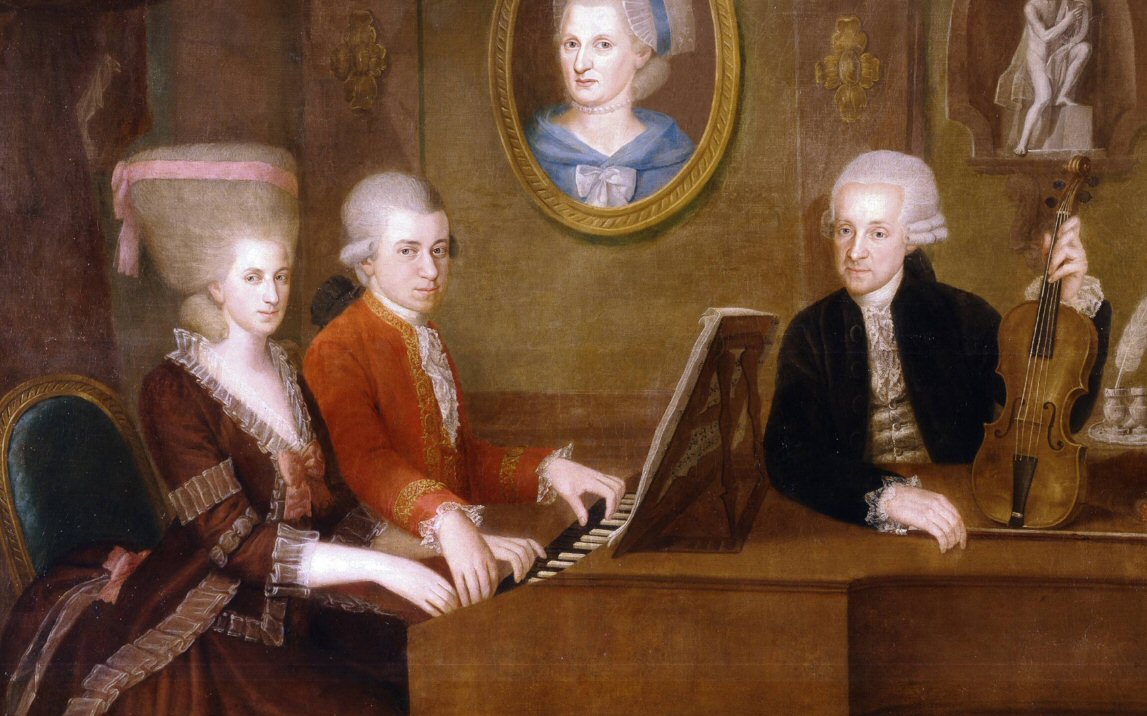
Mozart family (playing four hands) 1780 or 1781
(Mozart is 24-25) by Johann Nepomuk della Croce
Check out the 'big hair wig' on Mozart's sister Anna
and the Mozart family nose.
(Rick Steve's show showed this to be a fairly large
portrait
hanging in Mozart residence museum in Saltsburg Austria)
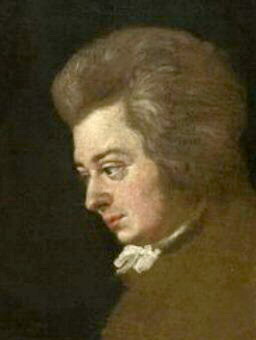 .
. 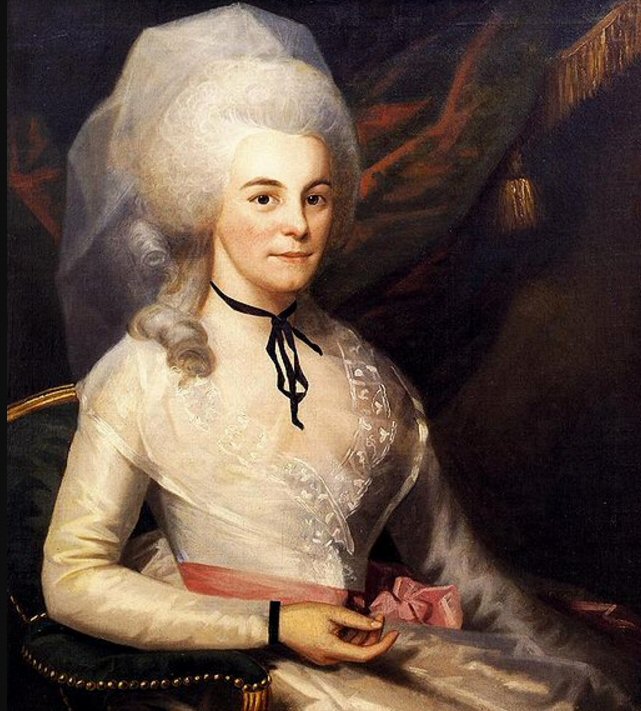
(left) verified portrait of Mozart painted by his
brother-in-law, Joseph Lange
(Mozart portrait article, NYT Feb 7, 2013)
(right) while not quite as extreme as Mozart's sister,
this portrait of Alexander Hamilton's wife shows she
also had 'big' hair in 1787 (age 30)
Closeup comparison of the two Mozart portraits
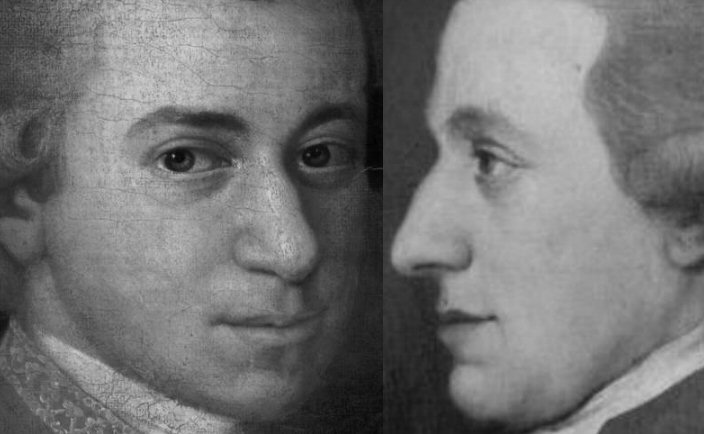
http://www.neuroscience-of-music.se/ormen/Hagenauer%20Mozart.htm
--------------------------------------------------------------------------------------------------
My amazon review of Sansa mp3 player
Pretty popular
device, more than 1,000 review!
Title: Two steps forward, one step back,
October 20, 2010
Comparison of Sansa Clip+ to Sansa Clip
Basics:
Sansa Clip+ sounds as good as Clip, same size, same battery, same screen,
somewhat different buttons and different clip design. The biggest functional
change is that Clip+ has a MicroSD slot for (low cost) memory expansion.
The power push button, replacing the slide switch of the Clip, is an improvement
because it does not need a fingernail to operate. I tested battery lifetime
of my new Clip+ (loaded by car Aux jack) and measured 17 hours, better
than spec. Package is nightmare to open, 20 minutes with pliers and a knife!
If any product needs the Amazon easier to open packaging, it is this one.
Better:
Screen scrolls significantly faster (6 sec vs 13 sec). Music List scrolls
much (x3) faster. These are both big improvements.
Worse:
Power up time (w/no expansion card) is much longer (12 sec vs 5 sec). This
slow boot time is a new annoyance and is probably related to the expansion
slot.
Unchanged
from Clip: Time to fill a 4 Gb clip is many hours (Auto Detect USB). Starts
out fast (1 sec/file), but soon slows way way down (15 sec/file or more).
For a 4 Gb fill you basically need to let it run all night. Why is file
Copy to the Clip+ so slow and variable? I want my mp3 files to list alphabetical
by filename, the same on Clip+ as on my computer. I found a trick online
years ago that explained the way to get an alphabetical listing on the
Sansa Clip is delete all filename tags (mp3 utilities can do this). This
works on Clip+ as well as on Clip. The order of files in the Music List
is clearly important, so why after years in production does the Sansa Manual
still not say anything about this?
Why
do Amazon technical specs give only the size and weight (0.8 lbs!) of the
Clip+ retail package? This is ridiculous, who cares what size the package
is, give the size and weight of the product. This is a problem I see all
too often in Amazon specs. Wake up Amazon.
------------------------------------------------------------------------------------------------------------
Mozart gems
End of 2nd
movement of 24th Piano Concerto
 .
. 

 .
. 
